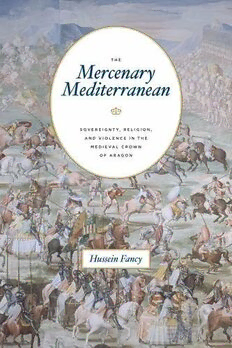
The Mercenary Mediterranean: Sovereignty, Religion, and Violence in the Medieval Crown of Aragon PDF
Preview The Mercenary Mediterranean: Sovereignty, Religion, and Violence in the Medieval Crown of Aragon
The Mercenary Mediterranean The Mercenary Mediterranean Sovereignty, Religion, and Violence in the Medieval Crown of Aragon hussein fancy the university of chicago press chicago and london hussein fancy is assistant professor of history at the University of Michigan, Ann Arbor. The University of Chicago Press, Chicago 60637 The University of Chicago Press, Ltd., London © 2016 by The University of Chicago All rights reserved. Published 2016. Printed in the United States of America 25 24 23 22 21 20 19 18 17 16 1 2 3 4 5 isbn- 13: 978- 0- 226- 32964- 2 (cloth) isbn- 13: 978- 0- 226- 32978- 9 (e- book) doi: 10.7208/chicago/9780226329789.001.0001 The University of Chicago Press gratefully acknowledges the generous support of the University of Michigan toward the publication of this book. Library of Congress Cataloging- in- Publication Data Fancy, Hussein Anwar, 1974– author. The mercenary Mediterranean : sovereignty, religion, and violence in the medieval crown of Aragon / Hussein Fancy. pages : illustrations, maps ; cm Includes bibliographical references and index. isbn 978-0-226-32964-2 (cloth : alk. paper) — isbn 978-0-226-32978-9 (e-book) 1. Soldiers of fortune—Spain—Aragon—History—13th century. 2. Soldiers of fortune— Spain—Aragon—History—14th century. 3. Foreign enlistment—Spain—Aragon— History. 4. Mudéjares—Spain—Aragon—History. 5. Muslims—Spain—Aragon— History—13th century. 6. Muslims—Spain—Aragon—History—14th century. 7. Muslims—Africa, North—History—13th century. 8. Muslims—Africa, North— History—14th century. 9. Aragon (Spain)—History, Military—13th century. 10. Aragon (Spain)—History, Military—14th century. I. Title. dp302.a7f36 2016 355.3'540946550902— dc23 2015028774 ♾ This paper meets the requirements of ansi/niso z39.48- 1992 (Permanence of Paper). For J and z ginete, n. Diego de Urrea dize que ginete, se pudo dezir de Cinete, que en terminacion Arabiga, es Cinetum, y sinífica ornamento del verbo Ceyene, hermosear, o ser hermoso, por la gallardia de los ginetes quando salen de fiesta con sus turbantes y plumas, sus marlotas, y borceguíes, y los jaezes de los cavallos ricos. [Diego de Urrea said that ginete could have come from Cinete, which in Arabic is Cinetum, and means ornament, from the verb, Ceyene, to em- bellish, or to be beautiful, on account of the gallantry of the ginetes when they parade in celebrations with their turbans and feathers, their adorned boots, their robes and the trappings of sumptuous horses.] sebastián de covarrubias, Tesoro de la lengua castellana o española (1611) Contents List of Illustrations xi Acknowledgments xiii On Names, Places, Dates, and Transcriptions xvii Introduction: A Mercenary Logic 1 chapter 1. Etymologies and Etiologies 16 chapter 2. A Sovereign Crisis 39 chapter 3. Sovereigns and Slaves 53 chapter 4. A Mercenary Economy 75 chapter 5. The Unpaid Debt 98 chapter 6. The Worst Men in the World 119 Epilogue: Medievalism and Secularism 140 Abbreviations 153 Notes 155 Bibliography 265 Index 299
